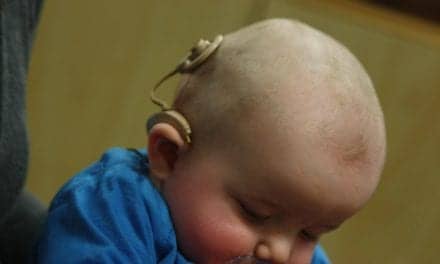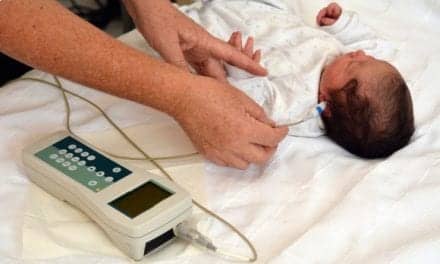The National Institute on Deafness and Other Communication Disorders (NIDCD), part of the National Institutes of Health (NIH), has reported that a research team using powerful microscopy techniques has pinpointed in mice the cellular location of two proteins known to be important for hearing and balance. The discovery provides additional evidence that the proteins, TMC1 and TMC2, are part of the channel complex that is essential for the inner ear to process sound and the signals that are key to balance.

Immunofluorescence of TMC1 (red) in confocal images of rat inner hair cell and outer hair cell stereocilia (green).
The study article appeared in the September 8, 2015 edition of Cell Reports, and was co-led by Bechara Kachar, MD, chief of the NIDCD’s Laboratory of Cell Structure and Dynamics, and NIDCD Scientific Director Andrew J. Griffith, MD, PhD. The findings expand knowledge of the structure of the channel, enabling scientists to further explore the mechanisms by which it functions. The findings also may lead to new insights into certain hearing and balance disorders.
The NIDCD reports that hair cells, which are topped by thread-like structures called stereocilia, are the key sensory cells in the inner ear. Mechanoelectrical transduction (MET) channels, which are thought to reside at the tips of the stereocilia tips, are critical to the cells’ function. An MET channel detects mechanical signals from sound vibrations or changes in our position and converts these signals into electrical pulses that are sent to and interpreted by the brain.
Scientists have learned a lot about how the MET channel functions, but its molecular structure has largely remained a mystery. TMC1 and TMC2 have long been suspected to be parts of the MET channel complex for several reasons. The structures of both proteins suggest that they reside in the hair cell’s membrane, as would be expected for parts of the molecular channel, and in the absence of the proteins, the MET channel doesn’t function normally. In addition, the TMC1 and TMC2 genes are turned on at the same time in development during which the MET channel becomes functional.
To further investigate the location of TMC 1 and TMC2 in the MET channel, the researchers tagged mouse hair cells with with fluorescent proteins and observed the proteins using high-resolution confocal microscopy. This advanced microscopy technique enables scientists to visualize cells in detail in three dimensions. The scientists uncovered the TMC1 and TMC2 localization pattern in hair cells, and their findings contribute to growing evidence that these proteins are components of the MET channel complex, and that they may be the pore-forming transmembrane proteins of the channel.
Source: NIDCD, NIH
Photo credits: Bechara Kachar and Andrew J. Griffith, National Institute on Deafness and Other Communication Disorders (NIDCD), National Institutes of Health (NIH)






